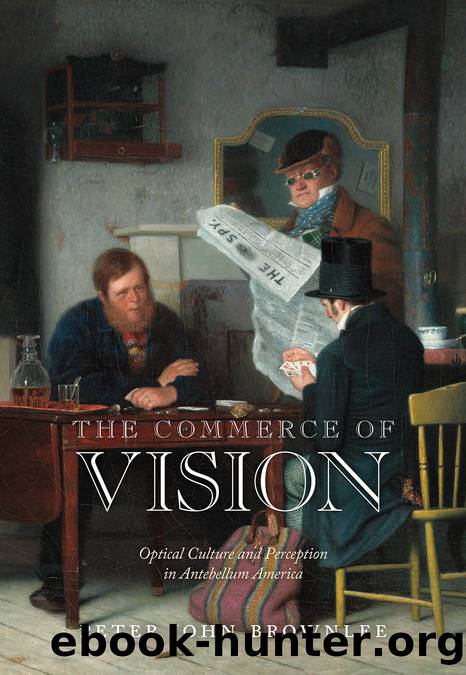The Commerce of Vision by Brownlee Peter;

Author:Brownlee, Peter;
Language: eng
Format: epub
Publisher: University of Pennsylvania Press
Published: 2019-11-14T16:00:00+00:00
The confused image of commodities mediated by signboards within an increasingly opaque commercial city suggests intriguing conceptual links between the experience of the marketplace and the ocular condition of myopia. In his famous formulation of the commodity fetish, Karl Marx asserts that the appearance of the commodity itself is already blurred because of the way it conceals the labor and the corresponding network of social relations responsible for its production.54 What Marx calls the âmistâ that envelops and obscures the true nature of the commodity extends to the consumerâs interaction with the purchased object. By its very nature, the commodity supplies one need as it produces another, offering buyers blurred impressions of a fleeting satisfaction that always manages to elude proper âfocus.â This sense of delayed or deferred gratification is, of course, the engine that ensures the continuance of consumer culture. The purchase and use of spectacles in the nineteenth century, to take one example, enhanced the observerâs view of print and signage, which in turn instigated desires that eventually led to the consumption of other goods. So while a commodity like spectacles helped to diminish the effects of ocular myopia, they actually helped to facilitate the myopic or shortsighted consumption encouraged by the capitalist marketplace. And though they facilitated a clearer view, spectacles could do little to diminish what many considered to be the marketplaceâs inherent capacity for duplicity, dissemblance, and deception. In the cultural landscape in which these market mechanisms and consumer practices emerged, advertisements that profitably utilized the lines of sight and âdemocraticâ vistas of the urban grid employed new forms of visuality to cultivate desires capable of leading the observer from advertisement to product. Signs and spectacles, exaggerated letterforms, and elaborate signboards helped lend shape to this new kind of observing subject, whose identity was based on ambulating, seeing, purchasing, and owningâall facets of what one historian has aptly called âcommercialized personhood.â55 Just as ink-saturated display types suggested surplus and surfeit, myopia provided an apt metaphor for visual relationships that signboards established between consumers and goods. Bombarded by the cityâs dizzying array of sights, the inability to see beyond oneâs nose, in a sense, indicated full integration with the market economy.
And so we return to the proximity of sign painter and optician in antebellum Philadelphia whose respective practices outline the ways that consumer subjects were formed by the market through a set of carefully manipulated links fostered between clearly articulated signage and properly gauged and optically assisted eyesight. Under their hands, both what antebellum observers saw in the streets of urban marketplaces and how they saw it became commodified phenomena simultaneously. Murphyâs phrase âeconomy is wealth,â intended to emphasize his ability to paint signs with âneatness and dispatch,â resonates equally with the McAllistersâ practice and the contributions their spectacles might make to the efficient and sparing use of a valued resource like vision. As opticians and ophthalmologists demonstrated, the eyes had economies of their own, and as such, they were the signboardâs most expedient targets for
Download
This site does not store any files on its server. We only index and link to content provided by other sites. Please contact the content providers to delete copyright contents if any and email us, we'll remove relevant links or contents immediately.
| Africa | Americas |
| Arctic & Antarctica | Asia |
| Australia & Oceania | Europe |
| Middle East | Russia |
| United States | World |
| Ancient Civilizations | Military |
| Historical Study & Educational Resources |
Never by Ken Follett(2866)
The Man Who Died Twice by Richard Osman(2287)
Machine Learning at Scale with H2O by Gregory Keys | David Whiting(2254)
Fairy Tale by Stephen King(2056)
Will by Will Smith(2026)
Rationality by Steven Pinker(1758)
The Dawn of Everything: A New History of Humanity by David Graeber & David Wengrow(1563)
The Dark Hours by Michael Connelly(1557)
Principles for Dealing With the Changing World Order: Why Nations Succeed and Fail by Ray Dalio(1368)
Friends, Lovers, and the Big Terrible Thing by Matthew Perry(1315)
A Short History of War by Jeremy Black(1295)
HBR's 10 Must Reads 2022 by Harvard Business Review(1250)
Go Tell the Bees That I Am Gone by Diana Gabaldon(1231)
Can't Hurt Me: Master Your Mind and Defy the Odds - Clean Edition by David Goggins(1215)
515945210 by Unknown(1205)
Fear No Evil by James Patterson(1101)
443319537 by Unknown(1068)
Works by Richard Wright(1017)
The 1619 Project by Unknown(985)
